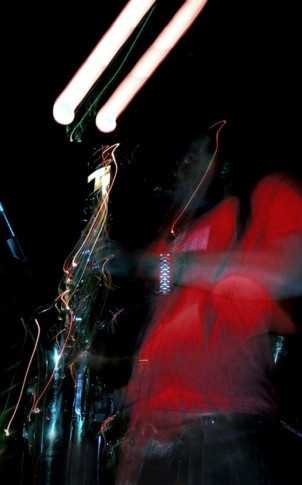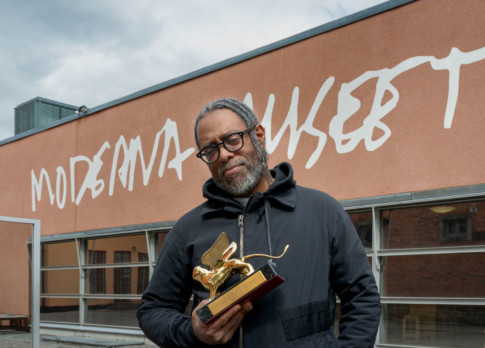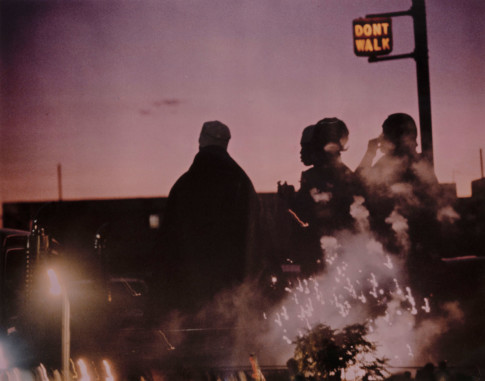
Arthur Jafa, Facetime Unavailable, 2016 Digital C-print © Arthur Jafa. Courtesy the artist and Gavin Brown’s enterprise, New York/Rome.
Arthur Jafa in conversation with Hans Ulrich Obrist
Hans Ulrich Obrist: Could you talk about the very beginnings: how you came to be an artist, a filmmaker, a cinematographer, a photobook-maker?
Arthur Jafa: I don’t know when the start was. Somebody asked my dad about the books specifically, and he said, ‘Well, he’s been doing a version of those since he was a kid.’ It’s basically a form of OCD. It’s not whether you’re neurotic or not, it’s whether your neurosis is productive or not. For a long time, there was nowhere I went where I didn’t have one of these heavy-ass books with me. At the smallest invitation, I’d flip it out and go like, ‘Yo, look at this. Look at this. What do you think of this?’ And my best friend Greg Tate would always say to others, ‘Have you seen the books?’ The tour of the books amounted to you looking at them whilst I did a running commentary about what was in them. Recently, I was watching another good friend of mine, John Akomfrah, give an interview, and he said something that struck me, because I feel it’s at the core of almost everything that I do. He said that essentially what he tries to do is to take things and put them in some sort of affective proximity to one another. That really hit me because I think for me, in a nutshell, that’s what it really comes down to.
I see things on the side of the road that I think are much more interesting than anything I’ve seen in art galleries.
I have a somewhat contentious relationship to the idea that some of these things are in fact art. Oftentimes I see things on the side of the road that I think are much more interesting than anything I’ve seen in art galleries. It’s not to say that I don’t like art galleries, but they do create a certain hierarchy of artefacts and how they’re valued or not valued. A few years ago, I was at Theaster Gates’s B.A.R. (Black Artists Retreat) in Chicago. I was amazed by how many artists thought that art had an inherent value. Art as a notion has value, but do specific things have inherent value? I don’t believe it at all. I think art is mostly about creating and assigning value to things.
I’ve said in the past that I think Black Americans, in particular, are preoccupied with things, because when we came here we were things. We weren’t people. We weren’t human beings. We were things of a very particular sort. I think that legacy of being things ends up creating a very complicated dynamic. Whether it’s a book, a photo or a piece of art, one’s relationship to that thing is complicated. What I’m interested in is the bringing of two things together, but I’m also interested in this idea that things gain whatever value they have, whatever assigned value they have, mostly through the context that they find themselves in.
HUO: I read a text where you tell an anecdote about your own beginnings and about an epiphany that happened in relation to the film ”Alien”. Could you tell us about this?
AJ: It goes back to the class of things. The alien is a monster, but in my reading of it, I think the first time I saw it, I realised that I was that alien. You’ve got a company that’s out there mining, or whatever they’re supposed to be doing in space, and you’ve got two… it’s funny using this term in mixed company, but I have to because it’s the appropriate term – it’s two niggers. There’s the good nigger and the bad nigger. The good nigger is Yaphet Kotto, who works for the company, and the bad nigger is the alien. When they first start to confront this xenomorph, is when John Hurt is at the dinner table, eating, and he’s like, ‘I’m feeling fine’, and then suddenly he starts having this seizure until the alien, in its first permutated state, pops out of his chest. If you look closely, there’s this moment where the whole crew is pulling back, except for Yaphet Kotto, who’s pushing forward with a knife in his hand. I always felt that that moment, where the baby version of the alien and Yaphet Kotto are facing each other, is a moment of recognition. This was the brother who couldn’t be reasoned with; the brother who said, ‘No, I come to rape and pillage and procreate with you whether you want to or not.’ It’s a sort of primordial vision of Black people in a way.
As is often the case with great science-fiction films, ”Alien” is bound up with these ideas of the Other. And the Other, as far as it exists in the Western imagination, is bound up with who Black people are imagined to be.
Over the years, I’ve been struck by the additional information that came out, which verified my feelings about the alien. For example, there was a 6′ 9″ Sudanese guy named Bolaji in the alien suit. Remember that this is Hollywood, where if a Black person gets a job, there’s a very specific reason why they’re getting that job. It struck me on some primordial level that it’s not an accident that they put this 6′ 9″ Sudanese guy in this suit. I also remember seeing one of H.R. Giger’s books in his studio, which had a picture of a Yoruba staff, an Elegba staff. If you look at that staff in the book, you actually see the alien’s head and where the design came from. As is often the case with great science-fiction films, ”Alien” is bound up with these ideas of the Other. And the Other, as far as it exists in the Western imagination, is bound up with who Black people are imagined to be.
HUO: The text ends on your idea of Black Visual Intonation (BVI). Could you tell us about some of the artists and filmmakers who’ve inspired you on this path to the invention of BVI?
AJ: As is often the case if you find yourself being a creative person, the things that influence you are unauthored. But I grew up looking at a lot of science fiction. The first time I was acutely aware of a person making a film that had a profound impact on me was certainly Stanley Kubrick. ”2001: A Space Odyssey” rocked me. I think to this day whenever I make something, I’m trying to replicate the experience that I had from viewing that film. My godmother bought me a copy of Arthur C Clarke’s novel when I was about eleven years old, and at the time there was a magazine, which still exists, called ”Popular Mechanics”. There was a series of articles about the making of this film, two or three years before it came out. When it finally came out, I was obsessed with it.
I really wanted to see the movie and my dad said, ‘Okay, when it comes to town, I’ll take you to see it’. It came to a drive-in outside of Clarksdale for just two nights, a Saturday and a Sunday. My dad wasn’t able to get me to it and to this day I still remember it as one of the most disappointing moments of my life. About a year and a half later, ”2001” came to Clarksdale, Mississippi, two years after it was released in the theatres everywhere else. I was really excited. My parents dropped me off there to see it at a matinee on a Saturday. It was me and maybe, if I remember correctly, two other couples sitting there at about noon, to watch the movie. I remember the movie starting and hardly anything after that. I used to say the film buried me alive. I lost consciousness in its presence. I remember they had an interval midway through the film, and when the lights came up, it was just me; the other two couples had abandoned it.
There’s hardly any dialogue for the first 20 or 30 minutes of the film. It goes from these big epochal leaps in time and then it slows down to almost real time, or slower than real time. It’s doing a lot of amazing stuff that you don’t associate with commercial cinema. The film ends with the famous psychedelic sequence as Bowman’s pod is drawn through space. Then there’s all this surreal stuff where he’s in the bedroom. I couldn’t make head or tail of it. I was completely flabbergasted in the face of it. I remember walking out of the theatre, and this is how I know this was a profound moment for me, because I remember it haptically, I remember it spatially. I remember the dimensions of the space, I remember the angle at which the light was coming in to the theatre, because it’s about two or three o’clock at this point. I remember the lint in the air, floating around in the light.
I was looking around like this and I only saw one person, the manager of the theatre. He was sitting over in the booth reading a newspaper. Older White guy. He seemed old at the time, because I was twelve. I walked over to him. At that point in my life I didn’t really have unchaperoned interaction with White people. It was very, very rare. But I walked over to him and said, ‘Excuse me, sir. I just came out of that movie, and … Can you tell me what it was about?’ He stops reading his paper, looks down at me and says, ‘Son, I’ve been looking at it all week and I have no clue.’ That’s the last thing I remember. I don’t remember how I got home. I don’t remember anything after him saying that. As a matter of fact, my younger brother reminded me a year ago that he was at the theatre with me. I don’t remember him at all.
It was a profound influence. To a certain degree, I think I’m always trying to figure out how to replicate the intensity of that experience. I think some of it is bound up with the fact that I was younger, where there’s a lot of gaps and things you just don’t understand. A lot of things for me are bound up in that moment. Mississippi is a very interesting and spooky place to grow up in, particularly the Delta. I was born in Tupelo, which is Northeast Mississippi. That’s the hill country. The Delta, which I moved to when I was seven, is very flat. It’s a very transient environment. I think, in some ways, the landscape itself predisposed me to be attracted to this kind of thing.
Then five or six years later, I discovered Miles Davis. I always felt that there was something very similar in the emotional tenor of his work and the emotional tenor of a film like ”2001”, which achieves an effect that I’m always trying to achieve, which is something that’s both voluptuous and austere at the same time.
how do you make a Black cinema with the power, beauty and alienation of Black music?
HUO: This brings us to the invention of BVI, which as you describe is ‘the use of irregular, non-tempered camera rates and frame replication to prompt filmic movement to function in a manner that approximates Black vocal intonation’. I once met Albert Hoffman, who discovered LSD, and who often told me the story of when the discovery happened. Also, Benoit Mandelbrot described in detail to me the day he discovered fractals for the first time. I’d love to hear about the moment you came up with this idea.
AJ: First of all, it comes out of a complicated set of positions and ideas that I’ve arrived it. It’s not an idea out of context. It’s an idea that’s bound up with working with my partners, Malik Sayeed, Elissa Blount-Moorhead and TNEG. Our continuing mantra is: how do you make a Black cinema with the power, beauty and alienation of Black music?
When I was in school, I came across a book called ”The Black Aesthetic” and another called ”Black Fire”. I remember reading in these books something by Stephen Henderson, a Black literary critic. He said that often when we compare poetry to, say, Charlie Parker, you would have a critic in the ”New York Times” saying ‘How can you compare the uncontrolled bombast of this poetry with the abstract precision of Charlie Parker?’, and the only response they had was ‘Shut up, Whitey’. To me this was not a legitimate response. If you say ‘Black cinema’, what do you mean by that? What are the constituent components of this apparatus that we term ‘cinema’, and then how do Black people come into play? One aspect of this idea was that it wasn’t enough for Black people to make these movies or for them to feature Black actors and narratives. On a more profound, deeper, structural level, the medium had to be in some ways commensurate or consistent with the worldview of Black people, Black being. To that end, I thought a lot about music. Music is this area in which Black people have an incredible amount of cultural confidence.
Nam June Paik, the godfather of video art, said that ‘the culture that’s going to survive in the future is the culture you can carry around in your head’, and I always felt like the Middle Passage was a profound example of that. If you look at African American culture, the places in which we’re super strong and have a lot of confidence are those areas in which our cultural traditions could be carried in our bodies. The incredibly rich traditions of architecture, painting and sculpture tended to erode in the Middle Passage, and, by extension, in our experiences after the Middle Passage. However, the places where we’re strong – oratorical media, music, dance – those are the things that we carry in our nervous system. Those are the spaces where our expressive traditions and our cultural artefacts are bound up with the experiences that we’ve had here in the Americas, the cultural context that we came from originally in Africa, and in some ways where we imagine ourselves to be going.
Music is this very privileged artefact in our community, so it seemed like the best place to start in terms of thinking about certain possibilities of Black cinema. The idea of Black Visual Intonation also came out of a desire to be moved more powerfully by the things that I love, which is cinema in this instance. I said, very immediately: ‘What makes Black music Black music? What makes it behave the way it behaves?’ That led to a formal analysis of it.
Most Western music uses a diatonic scale: do re mi fa sol la ti do. A lot of non-Western music uses what’s called just intonation, or they use notes that fall in between those notes, which inside of a Western tonal system are not considered legitimate notes. It’s not like these notes don’t exist, it’s just that for whatever reason, those notes were considered inappropriate. What you see in a lot of Black music is a tendency to ‘worry’ the note. The notational system cannot account for everything that’s physically happening in the music that made it work in real time. Black people tend to create notes that are inherently semi-stable sonic phenomena. There’s no such thing as a pure A-sharp or B-flat. It’s actually always vibrating. Vibration is the basis of the idea of Black Visual Intonation. I’ve been developing a system whereby you can take motion in cinema and manipulate it in accordance with these cultural presuppositions of Black vocal intonation.
HUO: This idea ties in with what Jean Rouch would often tell me: ‘How can we make film that moves as much as music?’ Could you give some concrete examples of what you’ve been explaining so beautifully?
AJ: It has to do with a certain kind of contextual dissonance. When you place a thing in a context that didn’t generate it, there’s a weird slippage or dissonance that happens, a certain movement. It’s almost as though the thing isn’t settled in the space that it’s in. In the past, I’ve talked about how the Black body in White space is this profound moment in the West, when this effect, this shivering, this troubled stasis kind of happens.
When African art came to the West, it created a profound re-composing of ideas of how you build imagery, space and time. Cubism came directly out of an apprehension of African artefacts, and it was Duchamp who realised that a lot of the power of these things came from contextual dissonance. African artefacts, which are in a sense stand-ins for Black bodies in White spaces, were producing this energy. Duchamp tried to figure out how to replicate that energy, and what he came up with was the urinal. For me, the urinal functions as a displaced Black body in space.
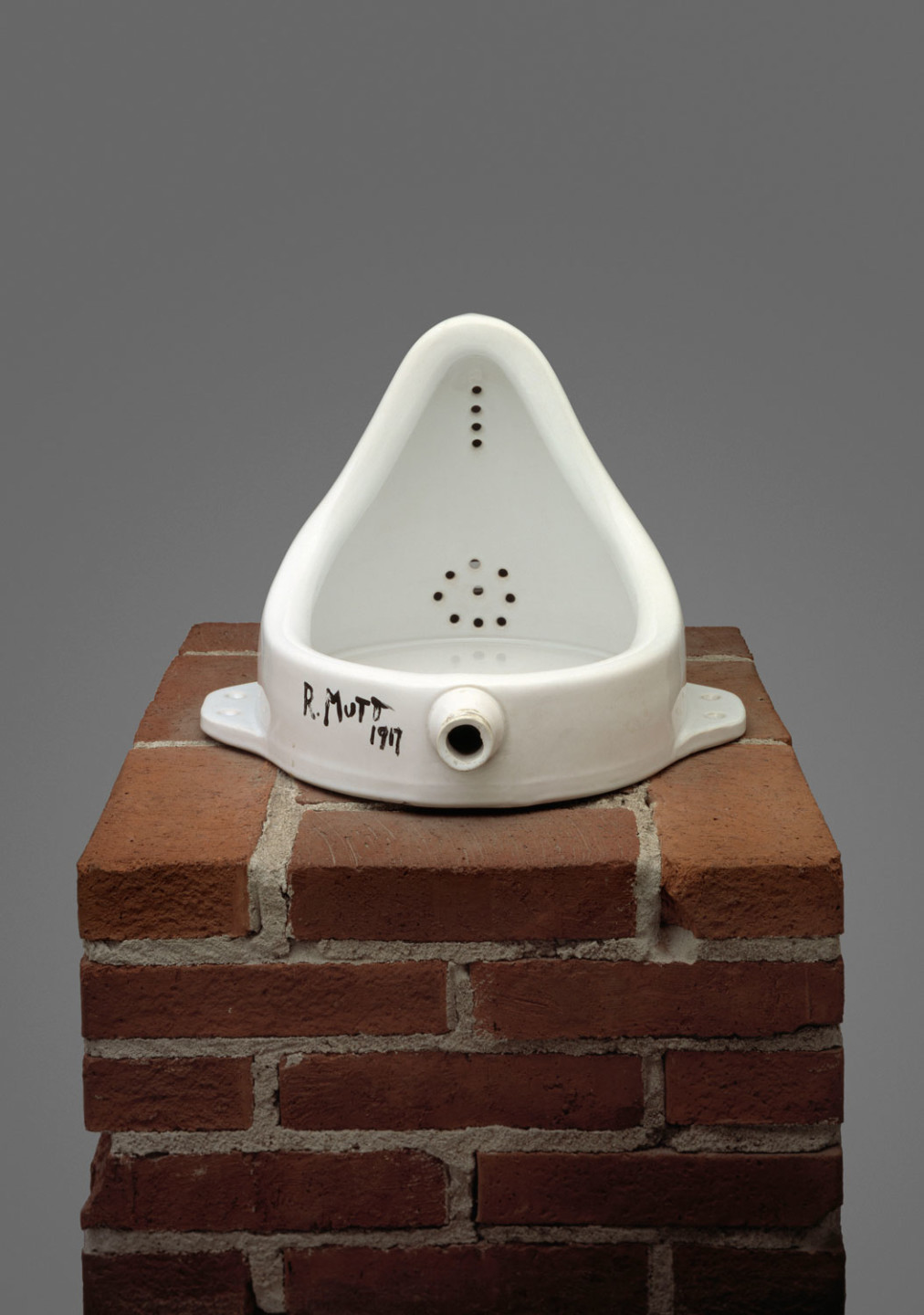
Ulf Linde 1963. Donation 1965 from The Friends of Moderna Museet. Photo: Prallan Allsten / Moderna Museet © Succession Marcel Duchamp / Bildupphovsrätt 2016
When you place a thing in a context that didn’t generate it, there's a weird slippage or dissonance that happens, a certain movement. It's almost as though the thing isn’t settled in the space that it's in.
There’s a book called ”Drylongso” by John Gwaltney, which is an oral portrait of Black America during the 1980s, and based around incredibly frank testimonials. In the introduction, Gwaltney states how he thinks one of the reasons he was able to elicit such open conversations from people was the fact that he was blind, so when he was interviewing them, he couldn’t see them. This connects to my film, ”Dreams Are Colder than Death”, which was an opportunity to test this idea. If you point a camera at a Black person, on a psychoanalytical level it functions as a White gaze. It therefore triggers a whole set of survival modalities that Black Americans have. It doesn’t matter if a Black person is behind the camera or not, because the camera itself functions as an instrument of the White gaze. In other words, it’s recording evidence of people speaking; hence there are certain things you can say, certain things you can’t say.
The central structural trope of ”Dreams” came out of a desire not to point cameras at people, so in the film you never see anybody actually talking. You hear them, but you don’t see them talking. Even though it comes out of these specific ideas that I’m talking about, it’s also completely bound up with this original idea of disjunction, dissonance, things being put in places that they’re not supposed to be, things not arriving where they’re supposed to arrive at. There’s a certain kind of power that happens when sound and image are in a contingent relationship as opposed to a fixed relationship.
HUO: Can we talk about your most recent film, ”Love is the Message, the Message is Death”?
AJ: The title is a conflation of two things. On the one hand, it’s a conflation of this song, ‘Love Is the Message’, which is a house music anthem by MFSB (Mothers Fathers Sisters Brothers), and a story by James Tiptree, who was really a woman: Alice Sheldon. I like to say she was the Jimi Hendrix of science fiction, because in the early ’70s, when James Tiptree’s first stories appeared, it just rocked everybody, but nobody knew her. She wrote a story called ‘Love is the Plan, the Plan is Death’, and in my mind, I enjoyed collapsing those two together.
The story itself is told from the perspective of a male member of an alien species, who, while fulfilling his cultural prerogative, is consumed by his progeny. He gets eaten at the end of the story. The title is therefore bound up with certain ideas I have around sacrifice. If you think of Martin Luther King, people treat his death as if it was an accident; they don’t contend with the degree to which he knew it was likely he was going to die. He made a profound sacrifice. I’m very curious about this idea of what it means to sacrifice oneself to a notion, to an idea, particularly when that idea is bound up with Black people’s survival.
Another book that’s had a profound impact on me is the ”Hagakure”, the Bible of the samurai. The ”Hagakure” comes down to one thing: ‘the way of the samurai is the way of death’. What this means is that samurais practice, as a conceptual exercise, the imagining of themselves as living corpses.
In other words, they think of themselves as being dead. This whole idea of adopting a posture that’s essentially one of death is something that I see in Black culture a lot. For example, when Black people say, ‘Be cool’, this is a way of saying ‘pretend to be dead so that the forces that are trying to destroy you will assume that they’ve already achieved their goal’. To me, that’s what being cool is. It’s rigor mortis. When Rodney King had twelve cops beating him, they were asked, ‘Well, why did you keep beating him?’ Because he wouldn’t be cool. He wouldn’t lie down like he was dead.
Even in its title, then, ”Love Is the Message, the Message Is Death”, is bound up with these complicated ideas around what it means to be alive and to not be alive at the same time, as a way of continuing to be alive, and what kind of cycle is produced by that. I was seeing this really amazing footage that’s coming up more and more now on YouTube as Black people start to document abuse. With phone cameras you increasingly start to see the insanity of it being documented. I could make a five-hour long version of the film if I wanted to. For me, ”Love is the Message” is about trying to re-sensitise people to the footage that we’re seeing all the time. On the other hand, it’s also addressing Black people directly. It’s saying, ‘Yo, keep moving forward; they knocked us down, we turn that shit into an art form. They hit us in the side of the head, we turn that shit into an art form.’ We can’t stop ourselves from being injured, but we can in a sense deflect the sort of insult that’s added to the injury.
HUO: You mentioned at the beginning that since your childhood you made photobooks, and of course, from 1990 to 2007, it happened very intensely and in a specific way. Could you tell us about this method?
AJ: After finishing the film ”Daughters of the Dust”, we’d collated a bunch of images informing the style and how we wanted the film to look. I’d always put the pictures in between the sleeves of a portfolio, and I’d flip through them and show them to people. At the end of the film, my friend Dana, the costume mistress, gave me a photo album that had those peel-away pages. I realised it could be a revolution right here with this little photo album. I went on a one-month rage of just cutting everything I had. I remember at a certain point I started cutting coffee-table books. There’s a book called ”Interpretations of African Art”, or something to that effect. There were two images in there that I was obsessed with, which to this day I’m still obsessed with. I was flipping through the book and I just said, ‘Oh, fuck it!’ I took my X-Acto and just started cutting the book up.
I would see an image, which was demanding to be emancipated from the context in which it found itself and placed next to where it was supposed to go
Affective proximity is a thing that happens when two things come together. Certain things seek to be next to other things. When I would flip through these books, I would see an image, which was demanding to be emancipated from the context in which it found itself and placed next to where it was supposed to go. It was like the levy broke and I just started cutting everything up. It’s a kind of ordering or things emerging and demanding to be themselves. It’s as if there’s a latent potentiality in things.
Black people’s relationship to potentiality is really incredible. I have this term: ‘Black potention’. Inside of Black being, inside of the lives and the continuity of Black folks in America, there exists a meta trope that’s to do with an unrealised capacity. For every Michael Jordan, almost everybody can tell you ten people who would wipe his ass on the basketball floor. It’s the same thing with singers. For every Aretha Franklin, there’s twenty people in churches who would have eaten her alive.
HUO: As well as music, I also wanted to talk about architecture, with which you began your career, but you decided not to pursue. Can you tell us a bit about this transition from architecture, becoming a conceptualist and taking an interest in immaterial things?
AJ: Black people being human beings was a big conceptual project. The publisher Paul Coates once said that enslaved Black people had to work from sunup to sundown. There was no moment to have a break. When the sun has gone done, there was this brief moment before you had to feed yourself, take care of whatever you had to take care of, and then you had to get to sleep. It was life or death getting to sleep. There was no messing around. You had to get to sleep. He asked, ‘What did they do in that moment?’, that moment in between finishing work and having to get to sleep. He said, ‘They imagined us.’
To me, that’s a profound conceptual moment, that enslaved Black people imagined who we are. They imagined me sitting here at a microphone having a conversation with a European about a book. That’s a huge conceptual leap. When I say I’m a conceptualist, in a sense it’s a sort of a joke. You know, a dead Black person, conceptually, is alive. It’s a psychic leap. It’s a leap out of arrested potentiality into a kind of actualisation.
I’m very interested in congregation. I’m interested in all the ways in which when Black people work together we have to work outside the given tropes of interaction – a Black sociality. People often say that ‘We can’t have egos. We’ve got to work together. We’ve got to be a collective.’ I don’t believe in that. I don’t believe we can’t have egos. If we look at our traditions, for example hip-hop, you couldn’t have more egos operating in the same space. It’s ego-driven, but when was the last time you saw a hip-hop record where one person was rapping on it? Never. Our relationship to ego and working together is different. We have to work towards that.
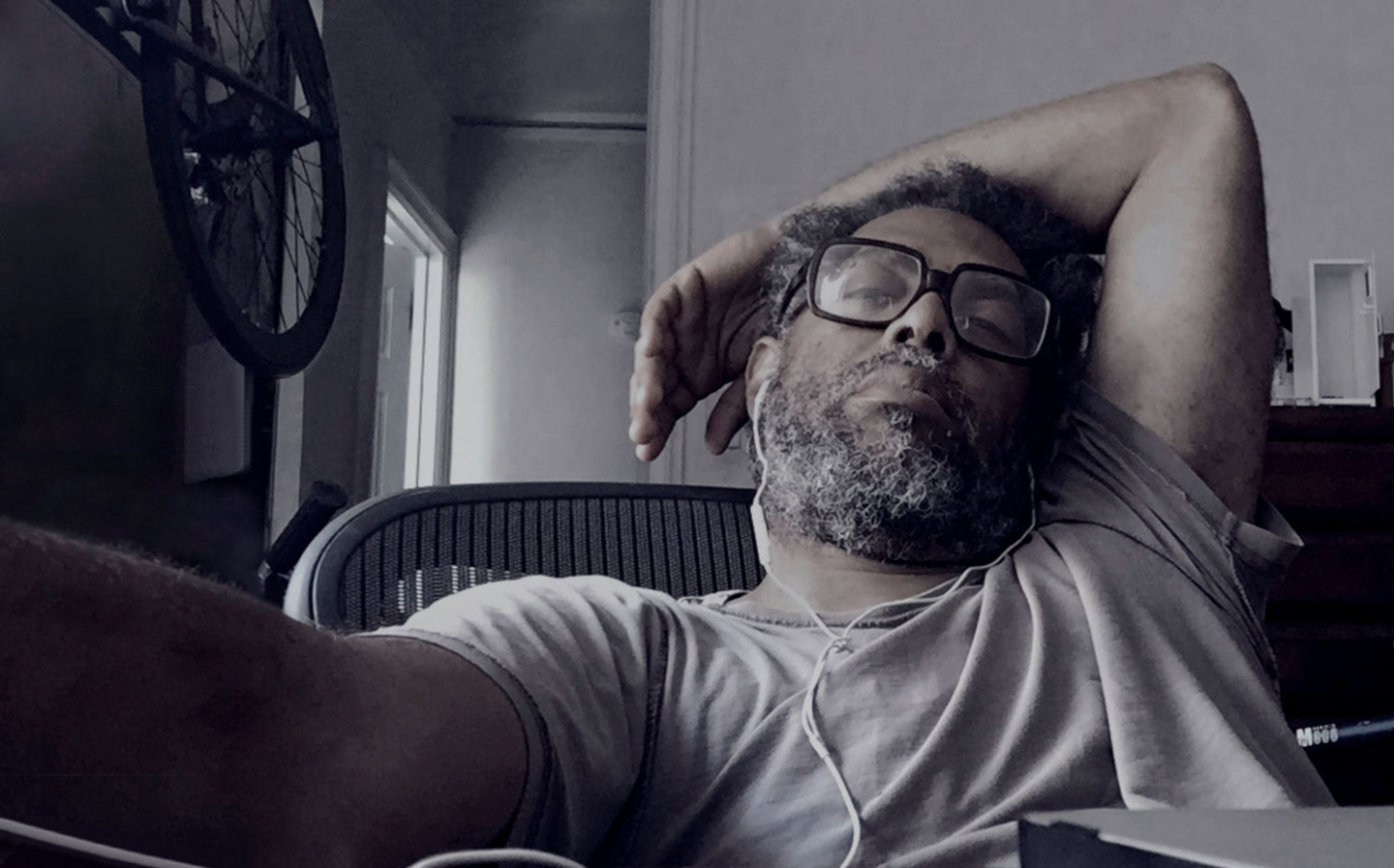
I made a piece called ”APEX”, which came as a result of stopping making physical books, when this whole practice of organising images basically migrated to my computer. I had this file called APEX that I was just obsessively calibrating, putting new images in, changing the order, colour-correcting them. Then one night, Malik Hassan Sayeed and Kahlil Joseph called me and asked me to come out to the studio. I went there and what they’d done was taken that file, APEX, and put it on a timeline, which was very strange. It’s strange to be the master of a universe, the dungeon master, and have somebody take your shit and do something else with it that seems perfectly logical after it’s done, but it just never occurred to you to do it. This is what I call passing back and forth between one another. I’m really invested in this idea.
HUO: This is also part of your practice, working together with lots of different people, for example the structure of TNEG. Could you elaborate on this?
AJ: TNEG grew out of my partnership with Malik Hassan Sayeed with curator Elissa Blount-Moorhead, the former whom I met on the set of ”Malcolm X”. Malik was the first person I ever met who heard me in a certain kind of way. Greg Tate always heard me, but he’s not a filmmaker. Malik was the first filmmaker who truly heard me. This goes back to the Paul Coates thing. If you have that moment when he said, ‘They imagined us’, you can’t imagine things by yourself. You imagine things in exchange with people.
If you say, ‘I’m this’, somebody should look at you and hear you say that and then affirm it. In a sense, I think TNEG initially grew out of a kind of feedback loop that Malik and I had around this idea of the way forward for cinema, for Black cinema first of all but cinema period: how do we concretely fold in the cultural, expressive and spiritual imperatives of Black people into this particular apparatus of cinema? TNEG grew directly out of our exchange, which is both aesthetic and technical. We were going in a circle for a long time and we always knew we needed a third partner. And then Elissa Blount Moorhead sort of happened. Everything is totally bound up with having achieved this triad.
Elissa and I just gave a talk at Creative Times’ Summit, and one thing I returned to was this idea that we’re not trying to be geniuses. We’re not trying to make masterpieces; we’re trying to make conversation pieces. We don’t even want to be producers; we want to go back to being a thing. By a thing, I mean we want to be emanations of culture. We want to be actual phenomena. What happens when the Black phenomenon manifests itself in cinema? That’s what I think we’re trying to get at. It doesn’t mean we don’t have egos or a sense of our own individual destinies, but I think collectively we’ve come to understand that in every instance in which transformative art happens, it’s never individuals. It always happens in discourse, in relation, in exchange.
HUO: Yesterday, as part of the Art Basel Miami conversation I did with Claudia Rankine and Glen Ligon (1), Claudia talked about her Racial Imaginary Institute and the necessity of creating a feedback loop, of creating a self-organised structure. She also talked about what she calls a state of emergency. Toni Morrison said, ‘This is precisely the time when artists go to work’, and Claudia presented a kind of manifesto for working. How do you see that current state of emergency and the idea of a manifesto?
AJ: This refers back to that problem of the gaze. I had a Yoruba reading done about who I was, my personality, and what I was here to do. The babalawo told me, ‘You’re a specialist. Meaning that inside of the continuum, you were put here to do a very specific kind of thing.’
There’s this great myth of the griot that I like to cite. In the African tradition, the myth of the griot goes something like this. There were two brothers who were taking a long voyage, an epic quest that had left them exhausted and they were about to return home. One of the brothers was a little stronger than the other, and the brother who was a little weaker realised he didn’t have enough energy to make it home. He told his stronger brother, ‘You keep going. I’ll catch up with you later.’ The stronger brother kept walking, and the brother who was weaker, he laid on the side of the road to die.
The brother who had walked forward at a certain point felt bad. He came back and saw his brother lying on the side of the road. He knew what was happening, so what he did was stop, took a knife, and cut his calf off. He took his calf and he put it over the fire and cooked it up. Then he went back to his brother who was lying down to die and said, ‘Hey, look what I found. I found food. You can eat. You can eat and you can get your strength back.’ So the dying man unknowingly ate his brother’s calf, regained his strength and they returned to the village.
Everybody was happy to see them, but when the people realised what had happened they ran away in horror. The brother who had unknowingly eaten his brother’s flesh realised what had happened when he looked down and saw his brother’s leg bleeding. He said, ‘From this moment onward, my sons and my daughters will sing the praises of your sons and your daughters. And their sons and their daughters will sing the praises of their sons and their daughters.’
This goes by way of explaining something about this specialist class that I call ‘griots’, or you could say ‘artists’. Griots feed on the flesh of the people, so when griots die in traditional contexts, they don’t bury them with everybody else. They put their bodies in trees and let the maggots eat them. This is because griots have this complicated relationship to the community at large. They document what happens, but they’re also bloodsuckers, because they feed on the flesh of the people. When I saw my brother crash his bicycle through a plate of glass and cut his leg, with white flesh open, I stared at it. I also went to get help, but there’s a part of me that’s always about testimony and bearing witness to what happens.
For me, this is bound up in this idea: I think we have to protest, I think we have to march, but I’m also very comfortable that I work in the lane that I’m in. When Trump was elected, I didn’t feel any particular way about it. I mean, it’s sad. The people of our communities who are the most precarious are probably going to bear the brunt of it, but the reality is, under a Black president for the last eight years, they’ve been killing Black people like we’re dogs. I never got so riled up about it, because for me, it’s all in life. This whole idea that we’re going to destroy life on Earth, we’re going to make genocide on nature, we’re going to make Earth unliveable: life isn’t going anywhere. People may go somewhere, but life isn’t going nowhere. Humankind can extinguish itself. There will still be life.
I don’t get caught up in emancipating that boat because that's just going to save some people. We're trying to save everybody. That means we have to go to the core of the logic that underlies white supremacy, patriarchy and homophobia.
I’m a specialist. I look because I’m a specialist. I have an image of walking the boardwalk and seeing a boat with a bunch of Black people in chains. This is an experience I have a lot. I have it in the art world. I look over and I think, ‘How come me and not that person? How am I getting all these advantages and opportunities and not that person over there?’ However, I don’t get caught up in emancipating that boat because that’s just going to save some people. We’re trying to save everybody. That means we have to go to the core of the logic that underlies white supremacy, patriarchy and homophobia. We have to fight it on that level. I don’t care about manifestos. I care about working with people that I care about and love, and having a common objective, and that objective is to create a space, an emancipatory space for everybody. Black people and everybody.
Hans Ulrich Obrist
Hans Ulrich Obrist (born 1968, Zurich, Switzerland) is artistic director of the Serpentine Galleries, London. Prior to this, he was the curator of the Musee d’Art Moderne de la Ville de Paris. Since his first show ”World Soup” (The Kitchen Show) in 1991 he has curated more than 300 shows.
He is the author of the Interview Project, an extensive ongoing project of interviews. He is also a co-editor of Cahiers d’Art Revue. Obrist’s Art of Handwriting project is taking place on lnstagram (https://www.instagram.com/hansulrichobrist/) and is a protest against the disappearance of handwriting in the digital age. Obrist has lectured internationally at academic and art institutions, and is contributing editor to several magazines and journals.
References
(1) Hans Ulrich Obrist in conversation with artist Glenn Ligon, writers Claudia Rankine and Frederick Iseman, ‘Artists’ Influences’, Art Basel Miami, December 2016.

